A Marine expeditionary force (MEF), formerly known as a Marine amphibious force, is the largest type of a Marine air-ground task force. A MEF is the largest building block of United States Marine Corps combat power.
Contents
| NATO Map Symbol |
|---|
 |
A Marine expeditionary force (MEF), formerly known as a Marine amphibious force, is the largest type of a Marine air-ground task force. A MEF is the largest building block of United States Marine Corps combat power.
| NATO Map Symbol |
|---|
 |
A MEF is larger than a Marine expeditionary unit (MEU) or Marine expeditionary brigade (MEB).
Each MEF consists of a MEF Information Group (MIG) as the command element, a Marine division (MARDIV) as the ground combat element, a Marine aircraft wing (MAW) as the aviation combat element, and a Marine logistics group (MLG) as the logistics combat element.
The MEF also contains a Special Operations Training Group (SOTG) and is the training section component for the MEU and MEB. The SOTG oversees the training and evaluation exercises for the MEU's annual Special Operations Capable Certification.
A MEF also commands several smaller MAGTFs, including MEBs and MEUs.
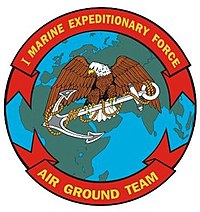


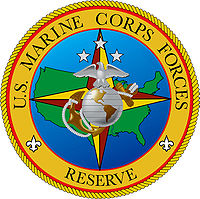
| Insignia | Name | Location |
|---|---|---|
 | ||
 |

Marine expeditionary units are the smallest air-ground task forces (MAGTF) in the United States Fleet Marine Force. Each MEU is an expeditionary quick reaction force, deployed and ready for immediate response to any crisis, whether it be natural disaster or combat missions. Marine amphibious unit (MAU) was the name used until the late 1980s.
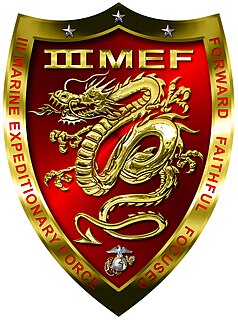
III Marine Expeditionary Force is a formation of the Marine Air-Ground Task Force of the United States Marine Corps. It is forward-deployed and able to rapidly conduct operations across the spectrum from humanitarian assistance and disaster relief (HA/DR) to amphibious assault and high-intensity combat.
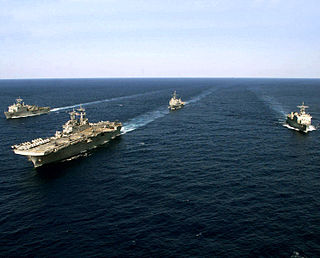
An amphibious ready group (ARG) of the United States Navy consists of a naval element—a group of warships known as an Amphibious Task Force (ATF)—and a landing force (LF) of U.S. Marines, in total about 5,000 people. Together, these elements and supporting units are trained, organized, and equipped to perform amphibious operations.
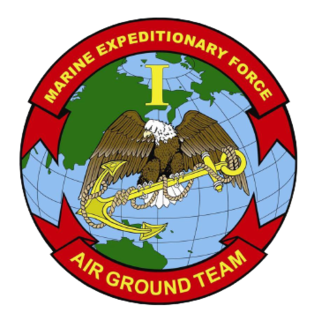
The I Marine Expeditionary Force is a Marine Air Ground Task Force (MAGTF) of the United States Marine Corps primarily composed of the 1st Marine Division, 3rd Marine Aircraft Wing, and 1st Marine Logistics Group. It is based at Marine Corps Base Camp Pendleton.
Combat service support is a topic that is, broadly speaking, a subset of military logistics. However, combat service support is often more limited in depth, as the related groups primarily address factors supporting readiness for combat operations. The United States Department of Defense organizes various agencies providing services such as medical assistance, for example, akin to other nations' militaries.

The II Marine Expeditionary Force is a Marine Air-Ground Task Force consisting of ground, air and logistics forces capable of projecting offensive combat power ashore while sustaining itself in combat without external assistance for a period of 60 days. The II Marine Expeditionary Force is commanded by a lieutenant general, who serves under U.S. Marine Corps Forces Command, providing Marine fighting formations and units to European Command, Central Command and Southern Command. The current Commanding General is Lieutenant General William Jurney. The Deputy Commanding General is Brigadier General Anthony Henderson.
Marine Air-Ground Task Force is a term used by the United States Marine Corps to describe the principal organization for all missions across the range of military operations. MAGTFs are a balanced air-ground, combined arms task organization of Marine Corps forces under a single commander that is structured to accomplish a specific mission. The MAGTF was formalized by the publishing of Marine Corps Order 3120.3 in December 1963 "The Marine Corps in the National Defense, MCDP 1-0". It stated:

The 11th Marine Expeditionary Unit is one of seven Marine Expeditionary Units currently in existence in the United States Marine Corps. The Marine Expeditionary Unit is a Marine Air Ground Task Force with a strength of about 2,200 personnel. The MEU consists of a command element, a reinforced infantry battalion, a composite helicopter squadron and a logistics combat element. The 11th MEU is currently based out of Marine Corps Base Camp Pendleton, California with headquarters in Camp Del Mar.
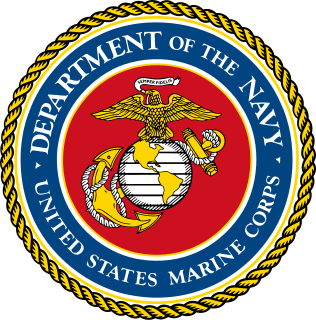
The United States Fleet Marine Forces (FMF) are combined general- and special-purpose forces within the United States Department of the Navy that perform offensive amphibious or expeditionary warfare and defensive maritime employment. The Fleet Marine Forces provide the National Command Authority (NCA) with a responsive force that can conduct operations in any spectrum of conflict around the globe.

The United States Marine Corps is organized within the Department of the Navy, which is led by the Secretary of the Navy (SECNAV). The most senior Marine commissioned officer is the Commandant of the Marine Corps, responsible for organizing, recruiting, training, and equipping the Marine Corps so that it is ready for operation under the command of the unified combatant commanders. The Marine Corps is organized into four principal subdivisions: Headquarters Marine Corps, the Operating Forces, the Supporting Establishment, and the Marine Forces Reserve.
In the United States Marine Corps, the ground combat element (GCE) is the land force of a Marine Air-Ground Task Force (MAGTF). It provides power projection and force for the MAGTF.

The 2nd Marine Expeditionary Brigade is a brigade of the United States Marine Corps. It is part of II Marine Expeditionary Force. It advertises itself as a "middleweight" crises response force of choice in the European and Southern Command Areas of Operation. It is able to "operate independently, as a service component, or to lead a Joint Task Force". Self-sufficient and interoperable, the 2nd Marine Expeditionary Brigade possesses a mix of command and control, combat power and specialized logistics. Operating as part of the greater Marine Corps team and with support from the United States Navy and other services, it can provide operational reach.

1st Marine Expeditionary Brigade is a unit in the I Marine Expeditionary Force and is the "middleweight" global crisis response force.
The United States Fleet Marine Force, Pacific (FMFPAC) is the largest maritime landing force in the world. Its units are spread across the Pacific Ocean and reports to the United States Pacific Command. It is headquartered at MCB Camp H. M. Smith, HI and directs and commands all the subordinate elements of the Navy Expeditionary Strike Force and Marine Air-Ground Task Force components that follow under the 3rd, 5th, and 7th Fleet and the Marine Corps Forces, Pacific (MARFORPAC). The Commanding General of Marine Corps Forces, Pacific is dual-posted as the Commanding General of Fleet Marine Force, Pacific. FMFPAC is under operational control of the Commander, United States Pacific Fleet (COMPACFLT), when deployed.
In the United States Marine Corps, the aviation combat element or air combat element (ACE) is the aviation component of the Marine Air-Ground Task Force (MAGTF). The ACE is task organized to perform the six functions of Marine Corps aviation in support of MAGTF operations. The ACE is led by an aviation headquarters which employs rotary-wing, tiltrotor, and fixed-wing aircraft in conjunction with command and control, maintenance and engineering units.
In the United States Marine Corps, the logistics combat element (LCE), formerly combat service support element, is the portion of the Marine air-ground task force (MAGTF) responsible with providing logistical support. It provides equipment and personnel to keep the MAGTF running logistically.
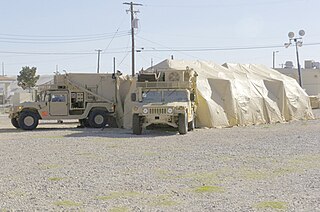
In the United States Marine Corps, the command element (CE) is the command and control force of a Marine Air-Ground Task Force (MAGTF). It provides C3I for the MAGTF.

Marine expeditionary unit (MEU ) was a program created by the United States Marine Corps and the United States Navy in the late 1980s for Marine expeditionary units (MEU). As of 2013 the term is obsolete. The program enhanced MEUs providing them with additional training and equipment to become certified as special operations capable with a Maritime Special Purpose Force (MSPF). The designation special operations capable was unique to the Marine Corps and meant in relation to special operations. The role of a MEU(SOC) however was not equivalent to the special operations role of special operations forces. Although considered special operations capable a MEU(SOC) did not form part of the United States Special Operations Command (USSOCOM) established in 1987 or the United States Marine Forces Special Operations Command (MARSOC) later established in 2006.
The Special Operations Training Group, or SOTG, is a training section of the United States Marine Corps providing Marine Expeditionary Force (MEF) commanders with training facilities and a liaison for Marine Expeditionary Units (MEU). The SOTG provides special operations training for various branches and also participates in the MEUs' Special Operations Capable Certification by acting as the "Training and Evaluation Board" for the exercises and events during the MEU annual training cycles.